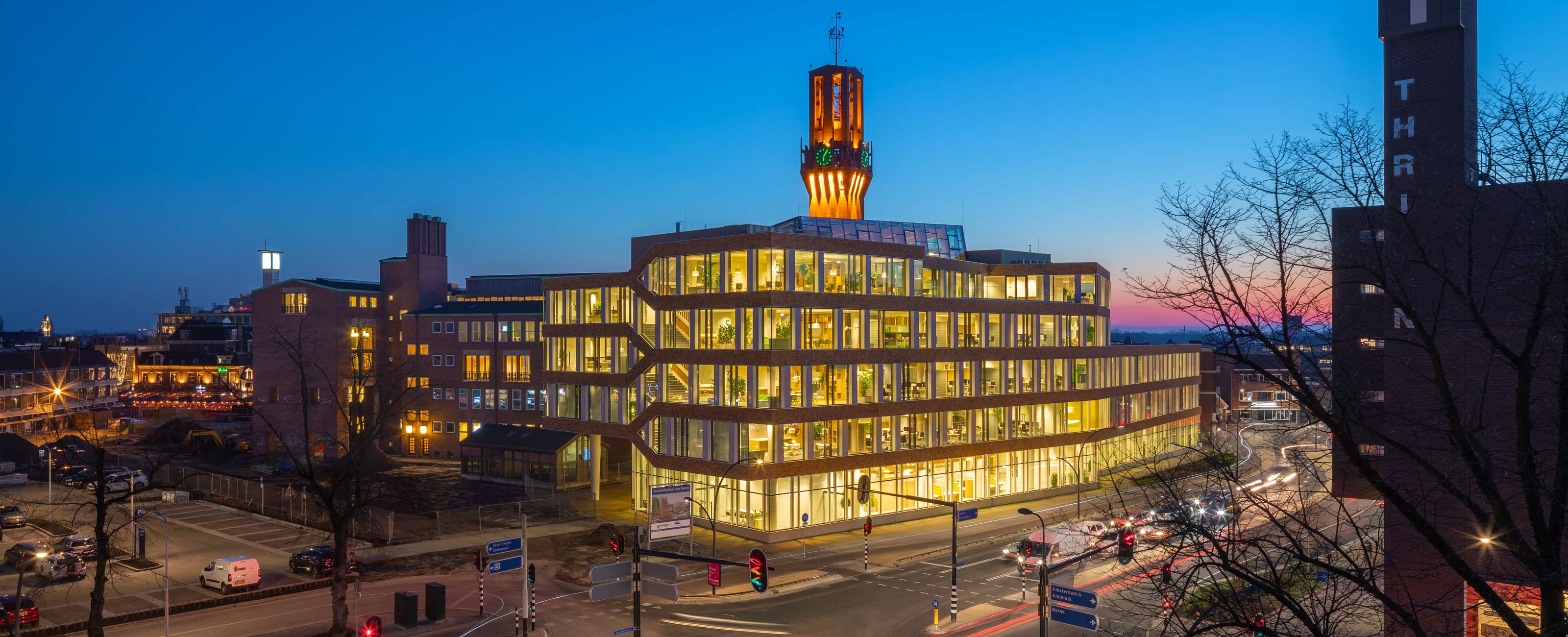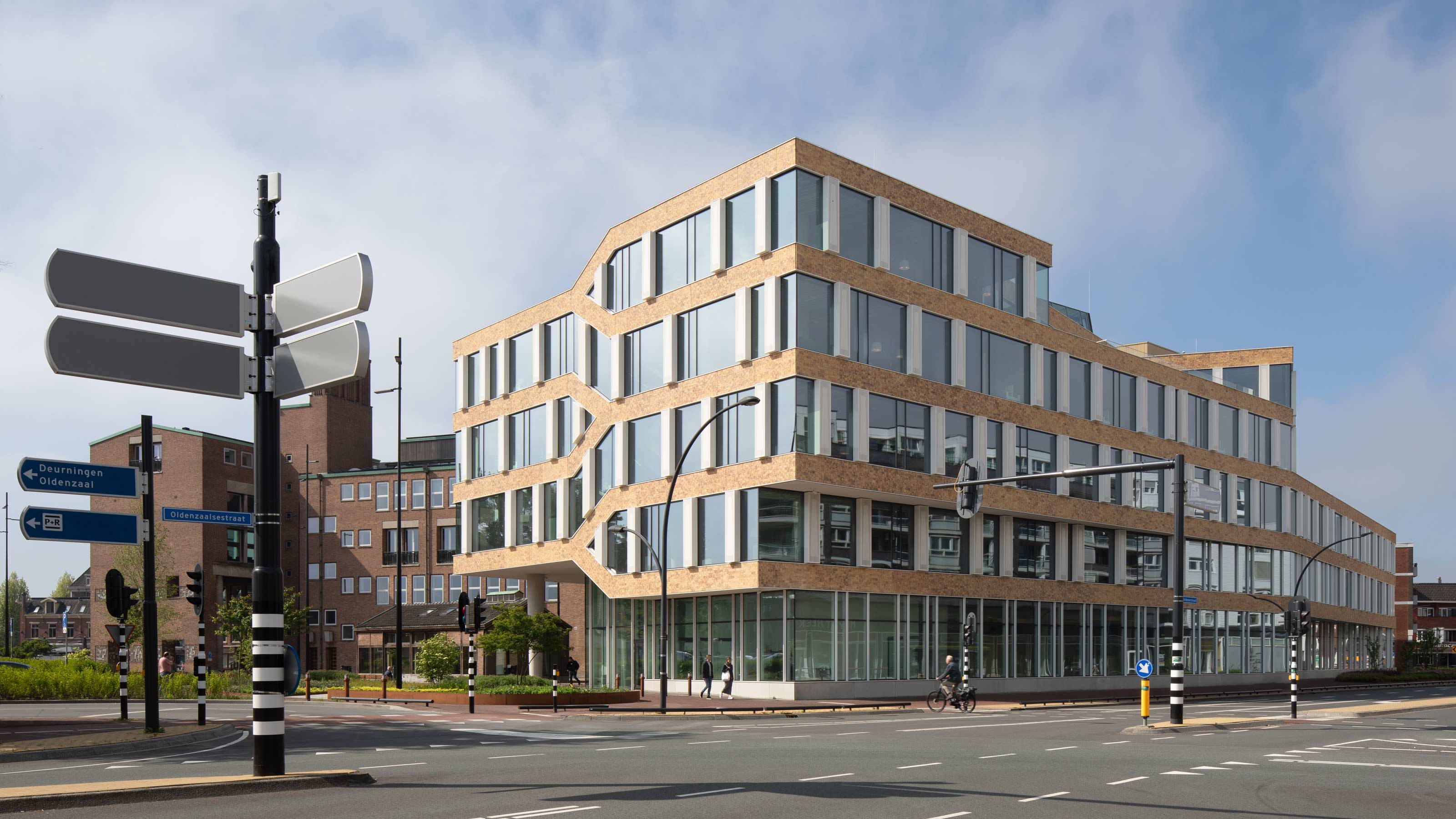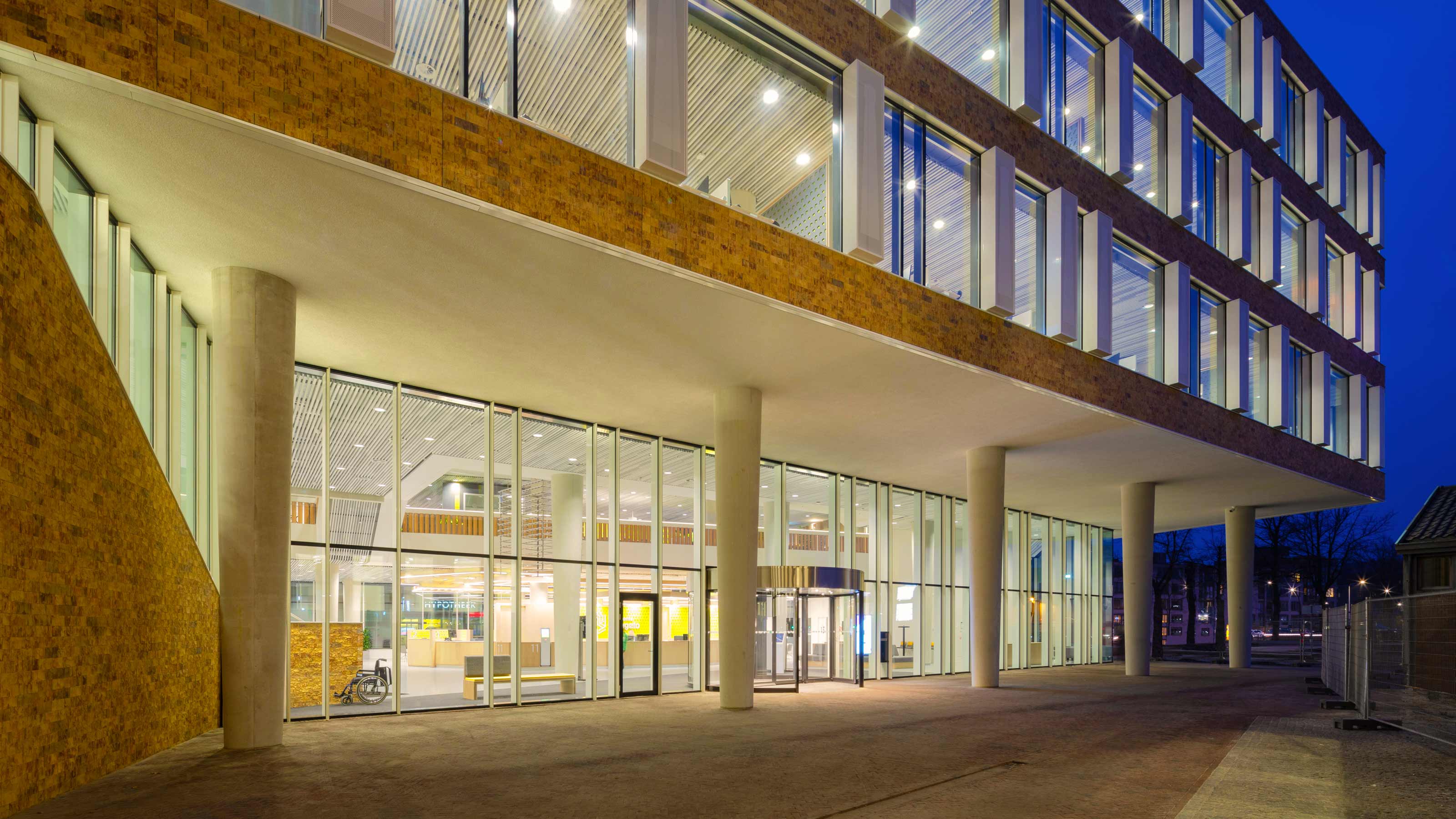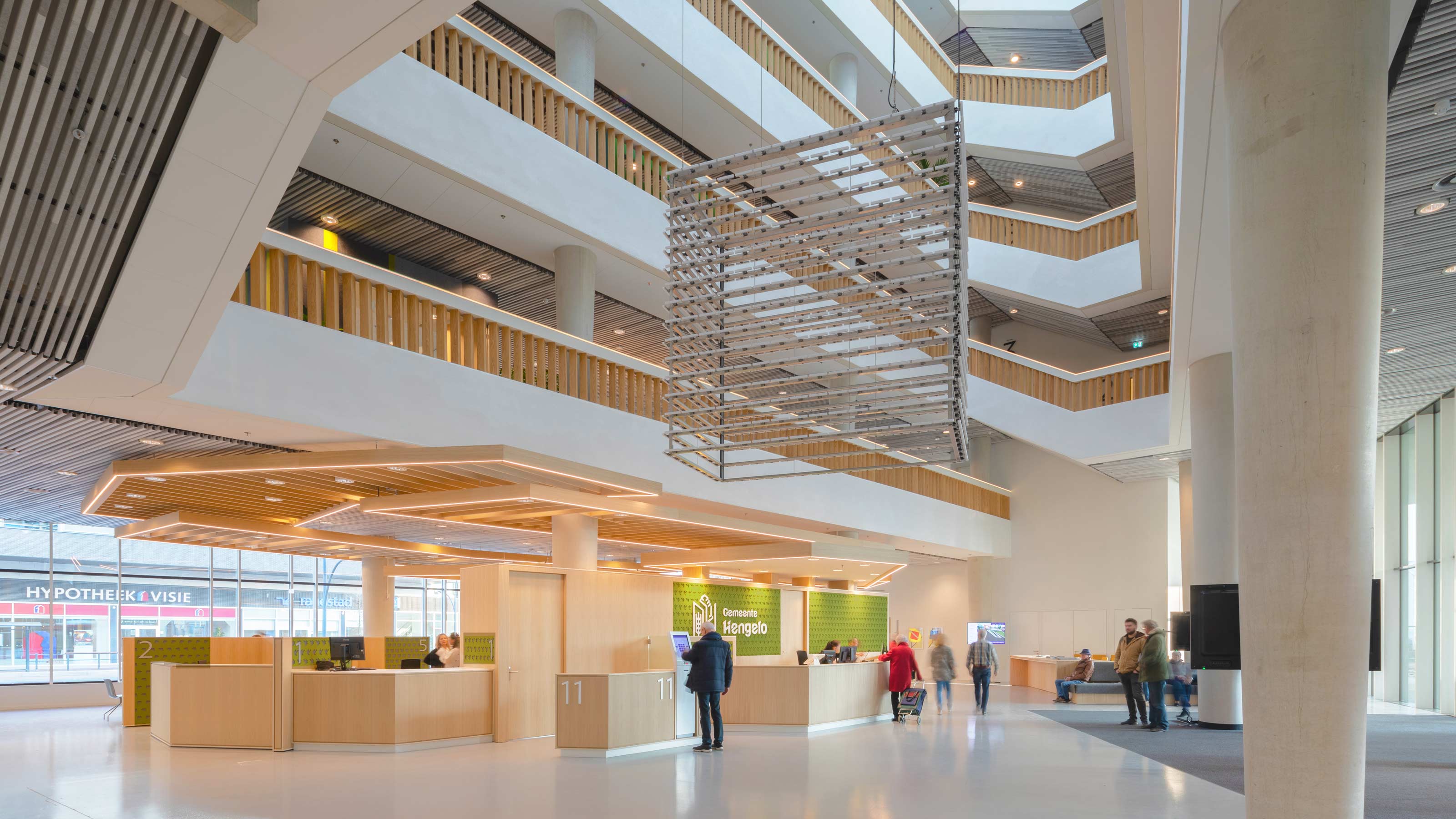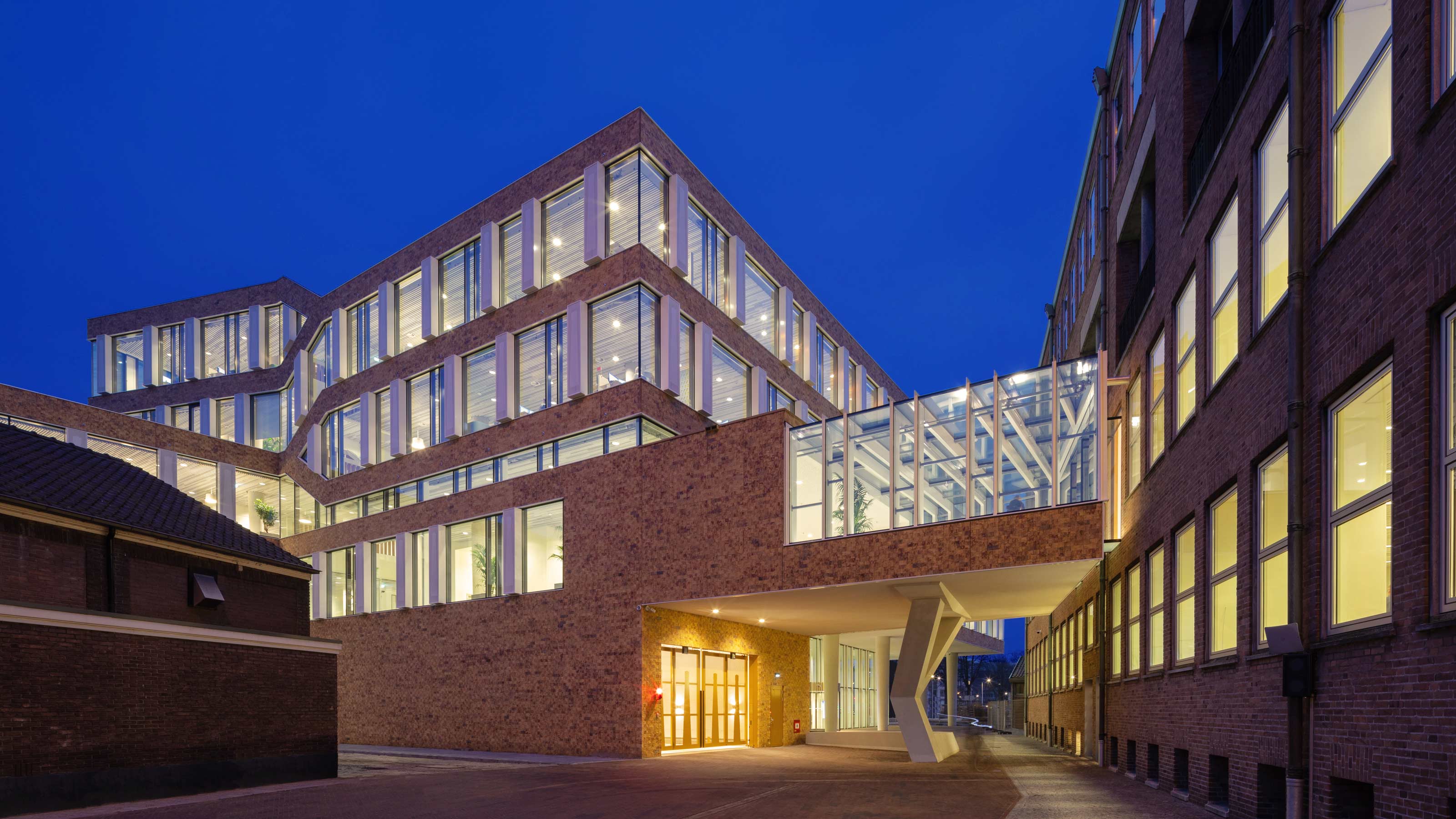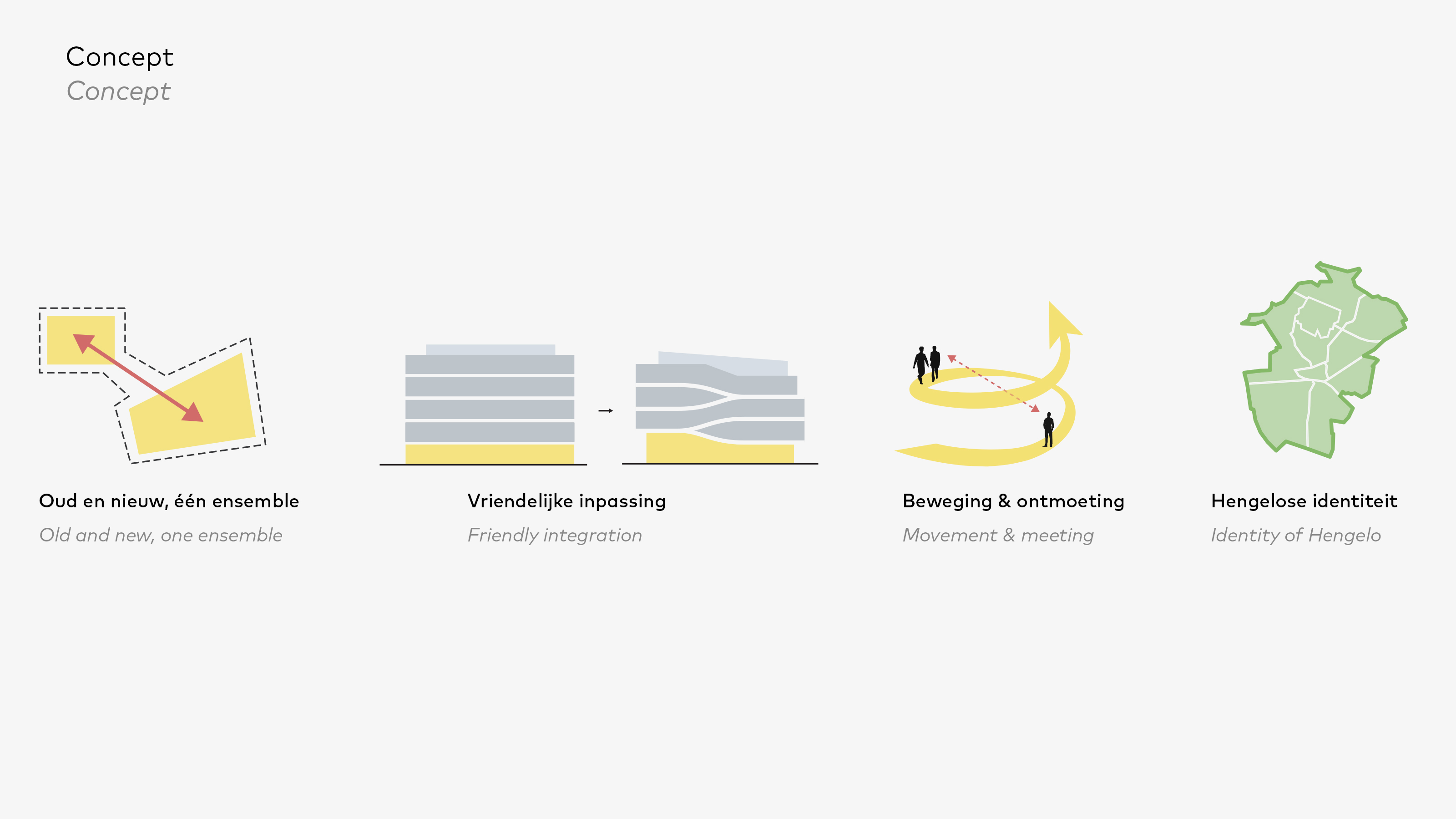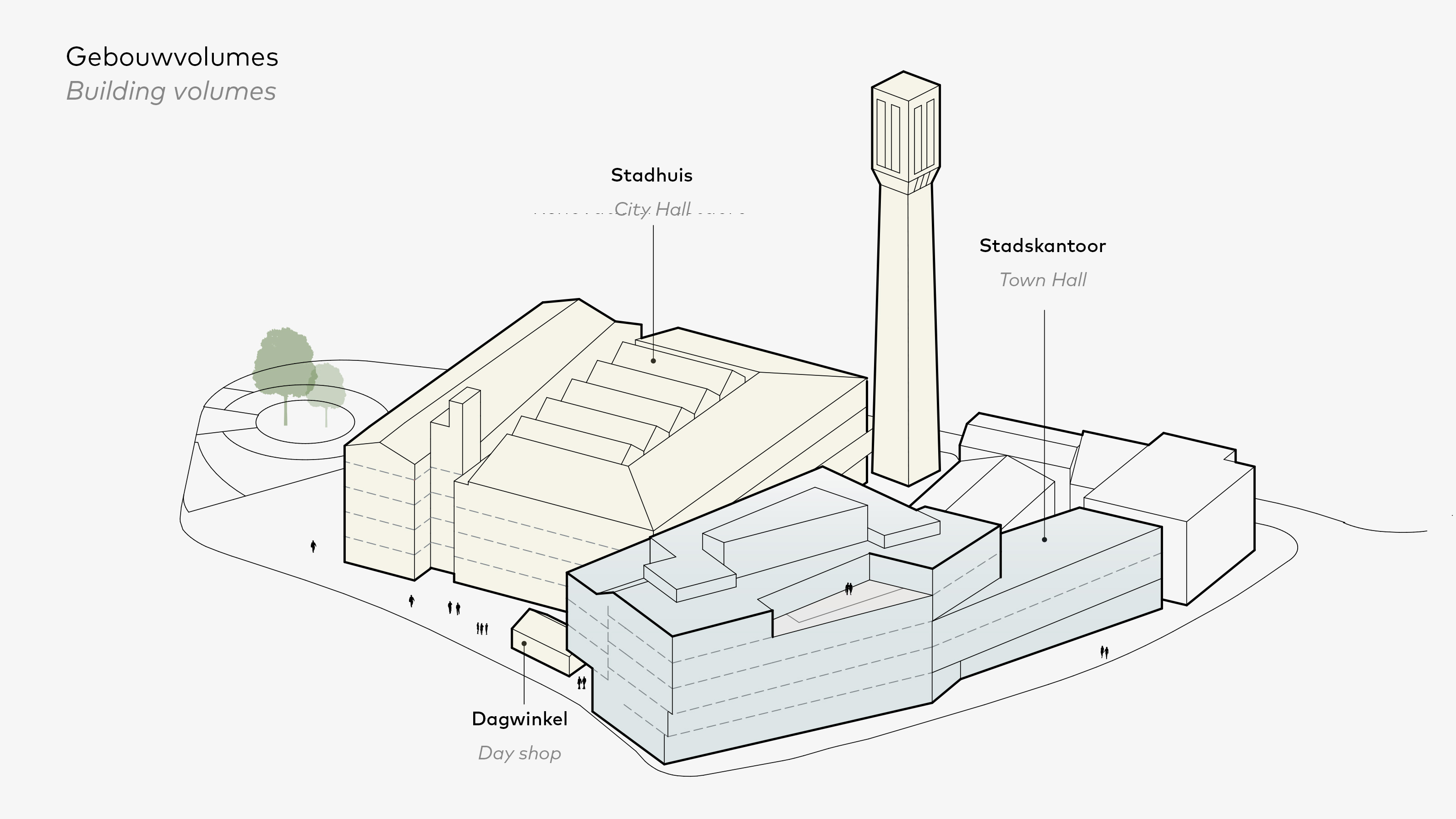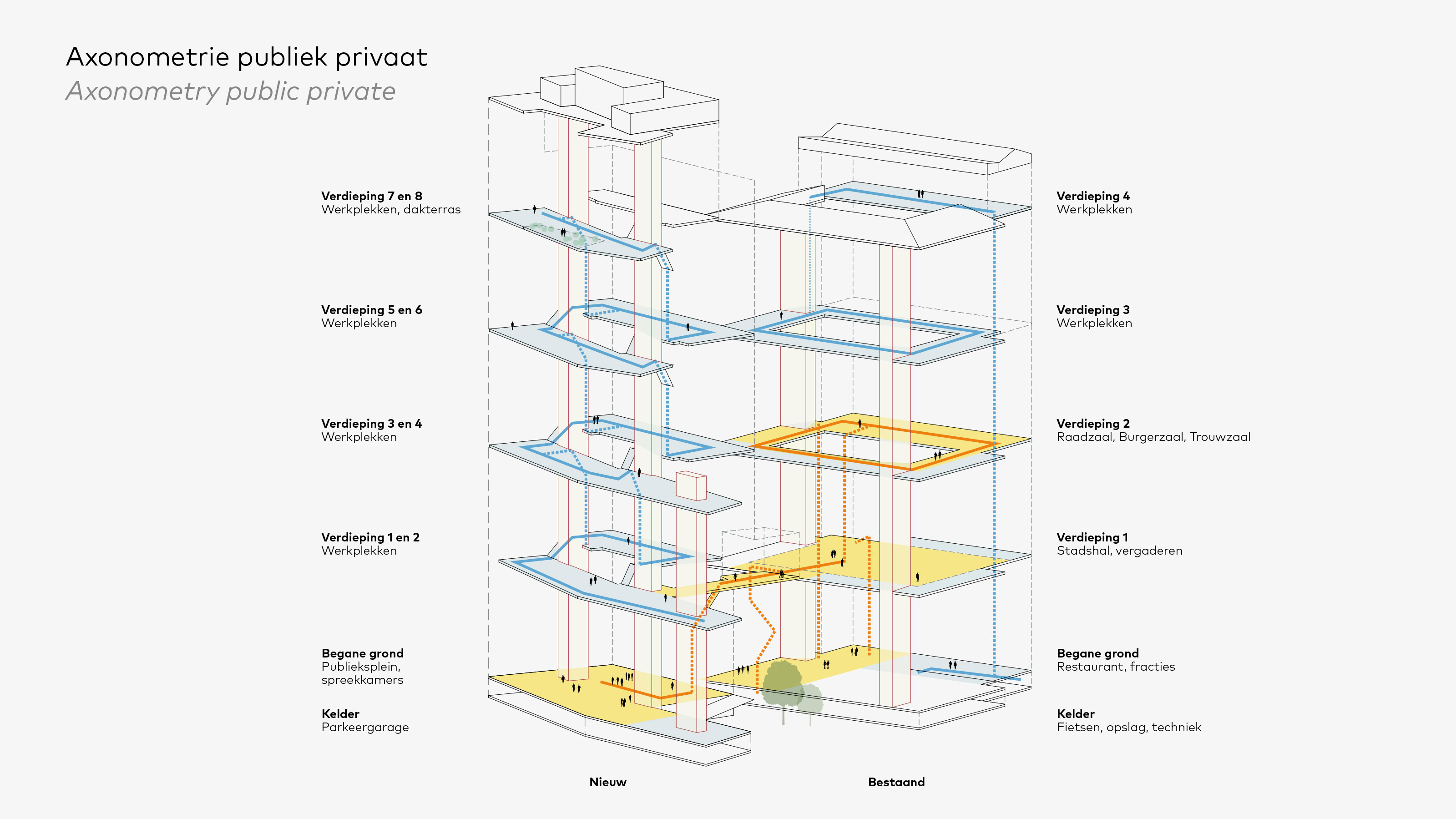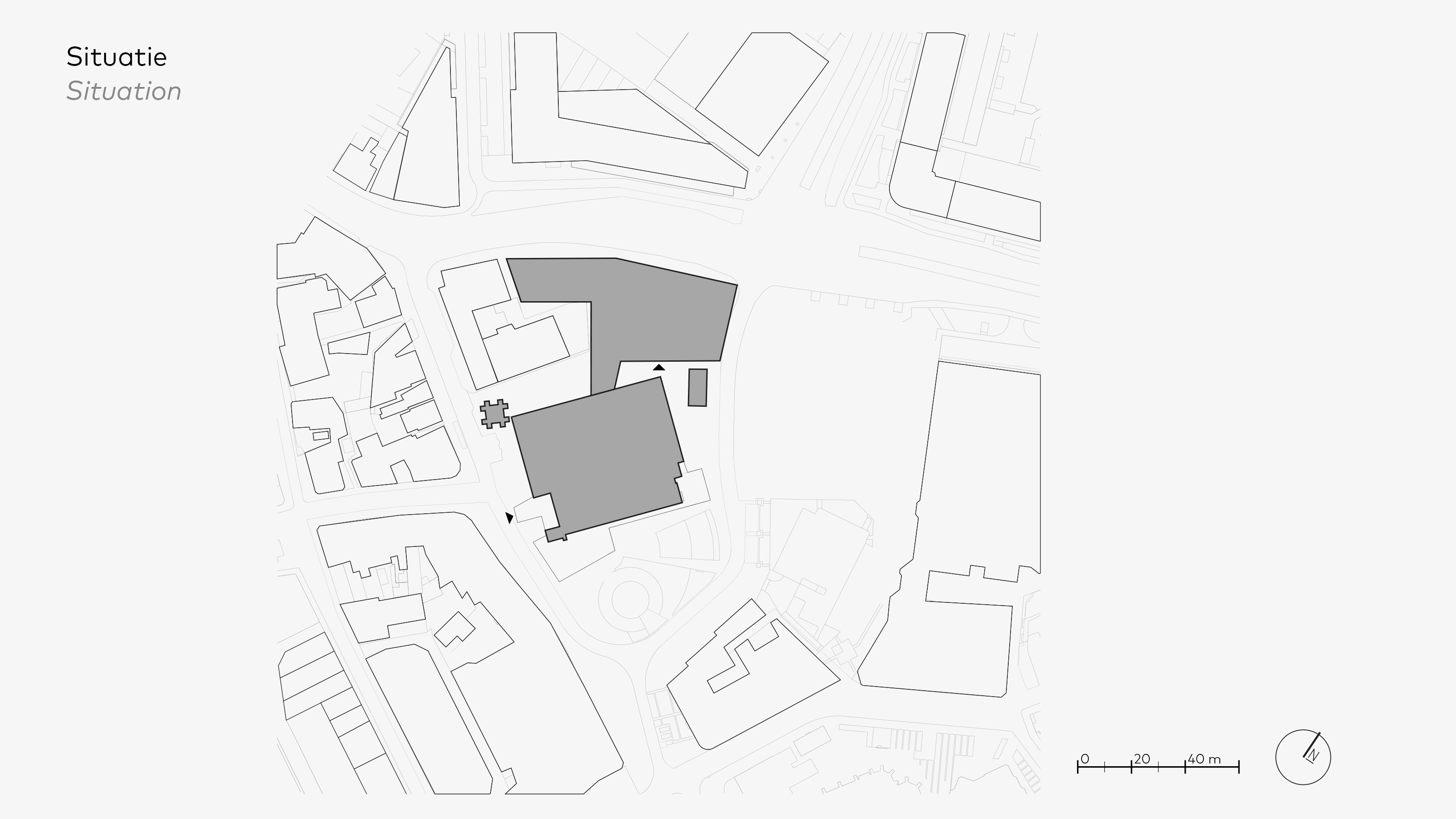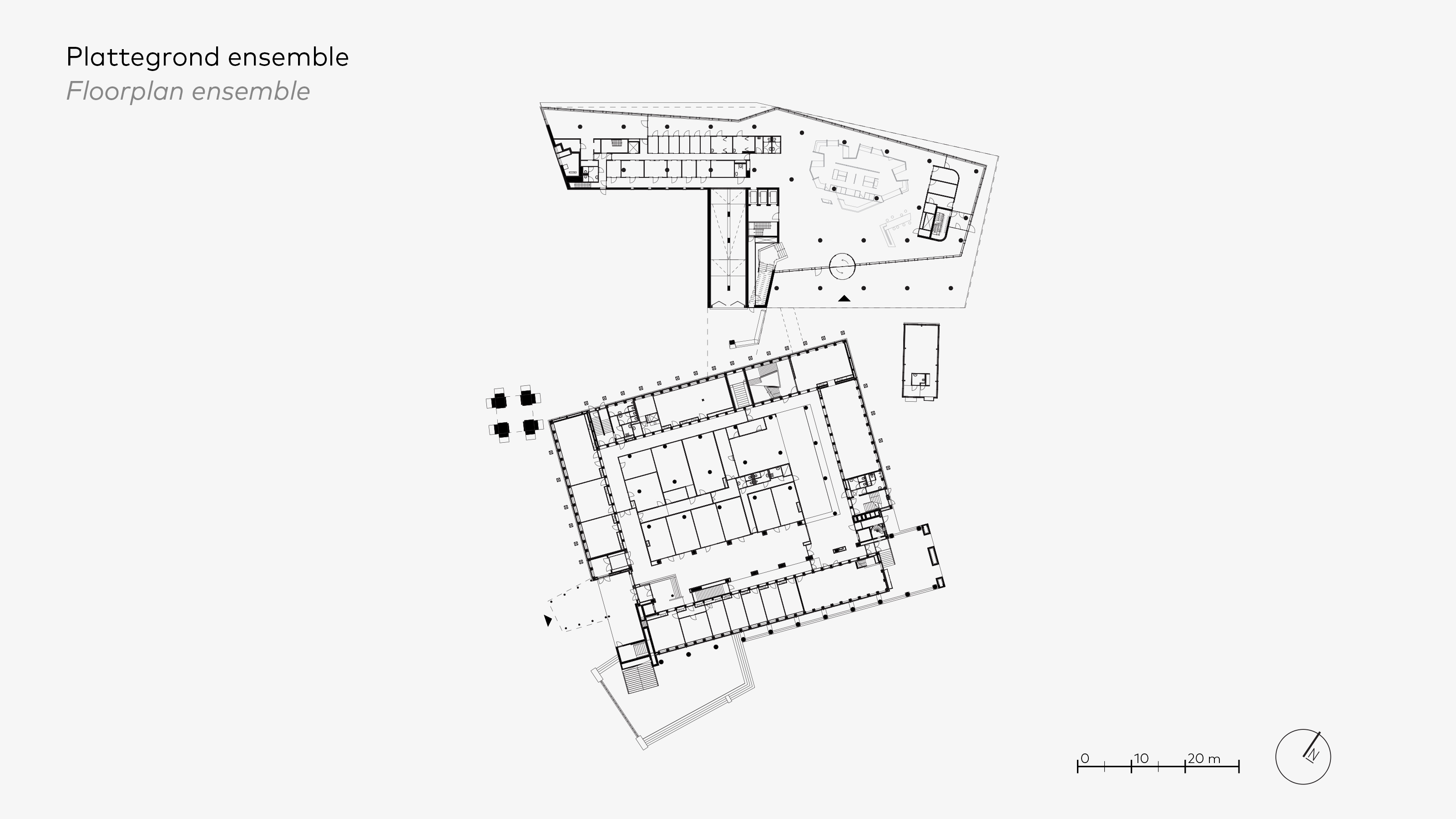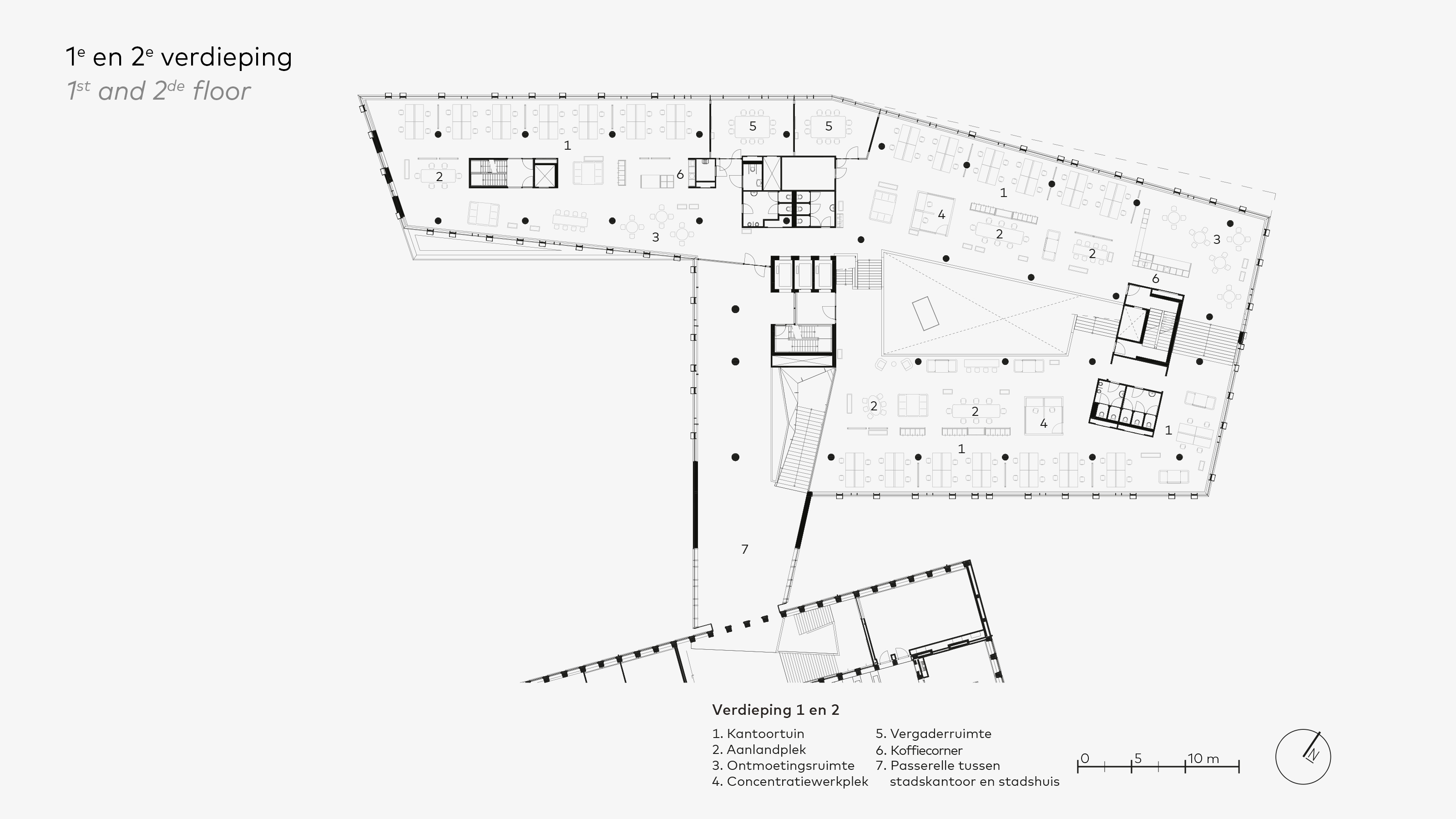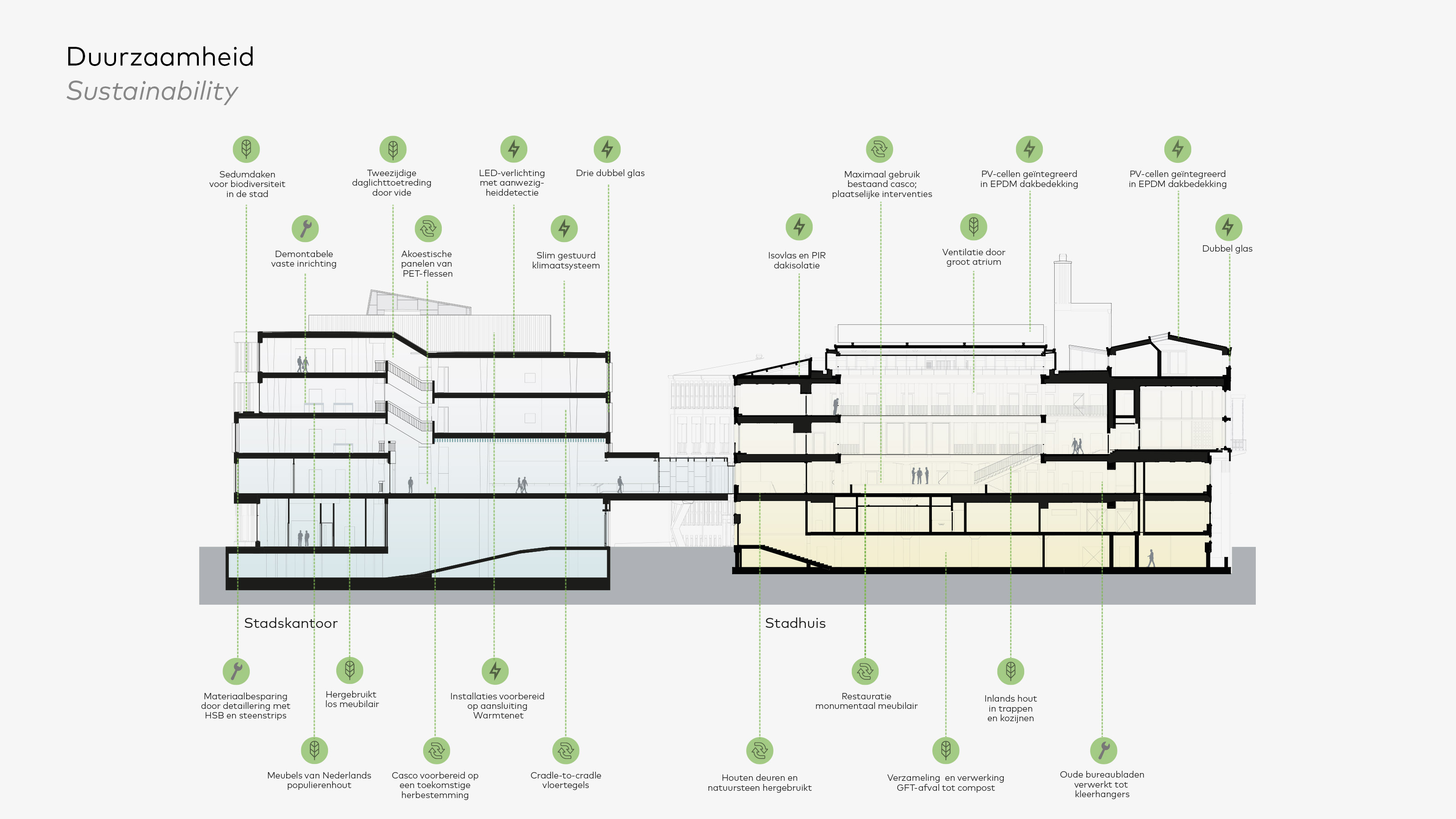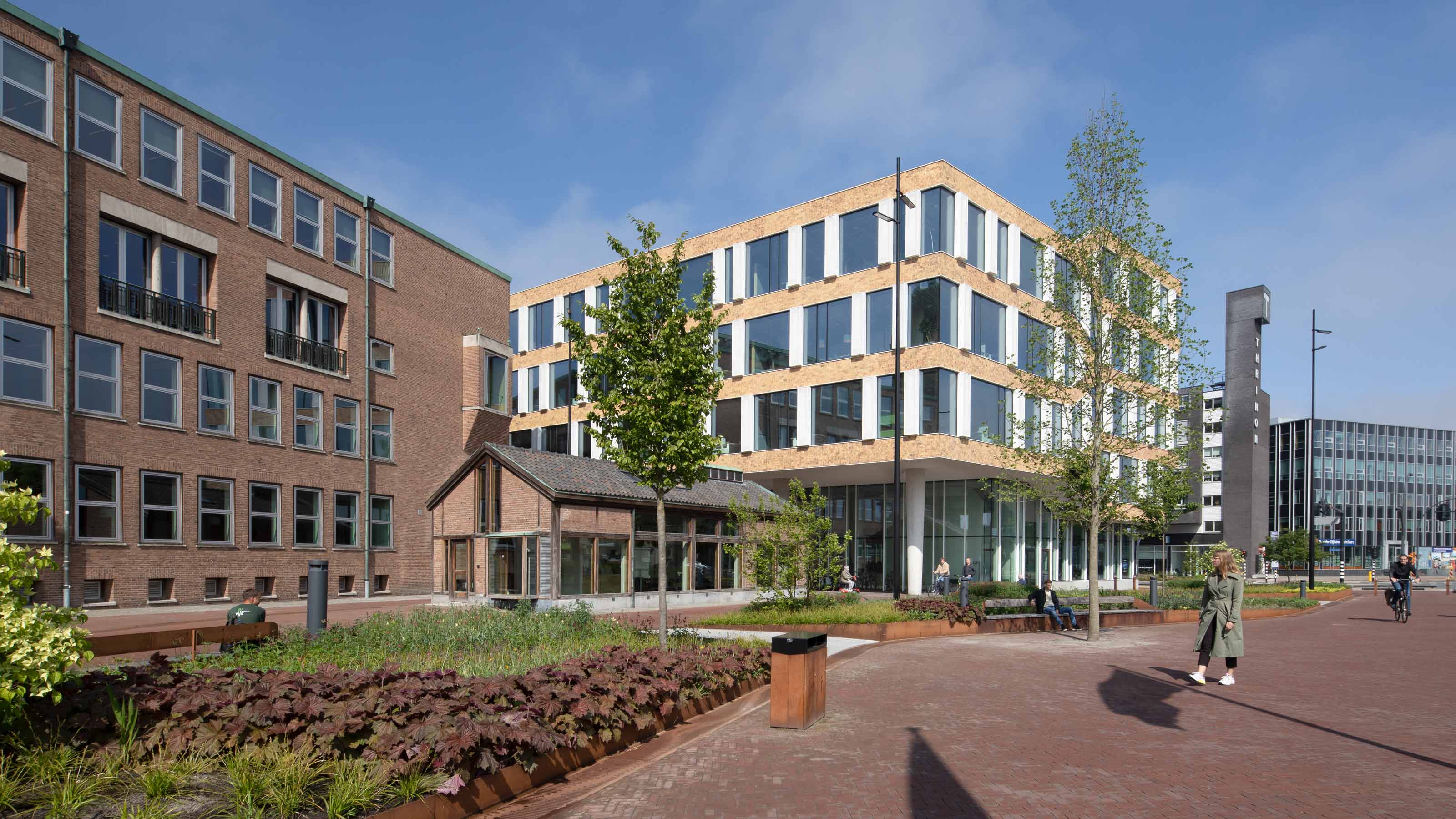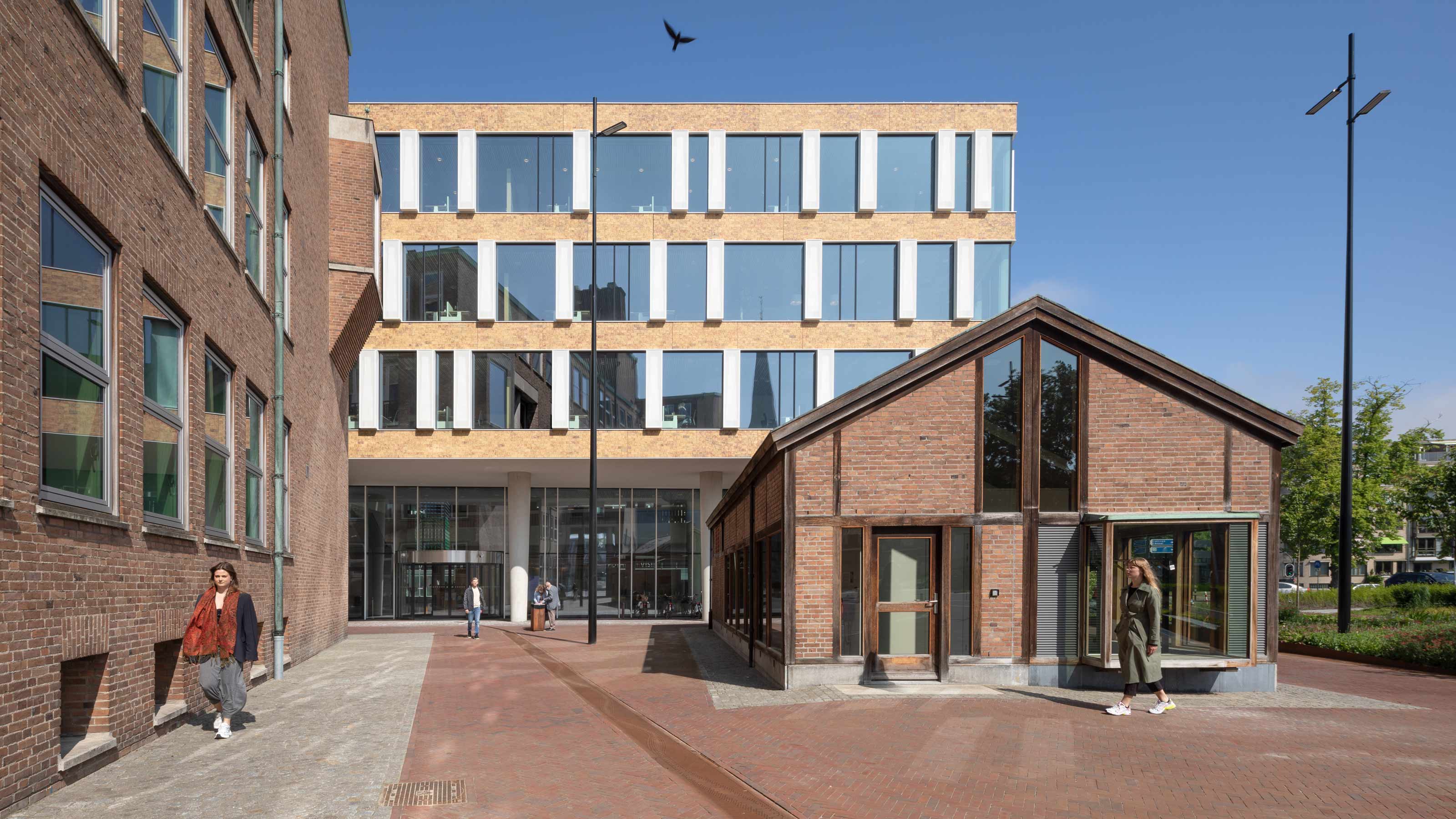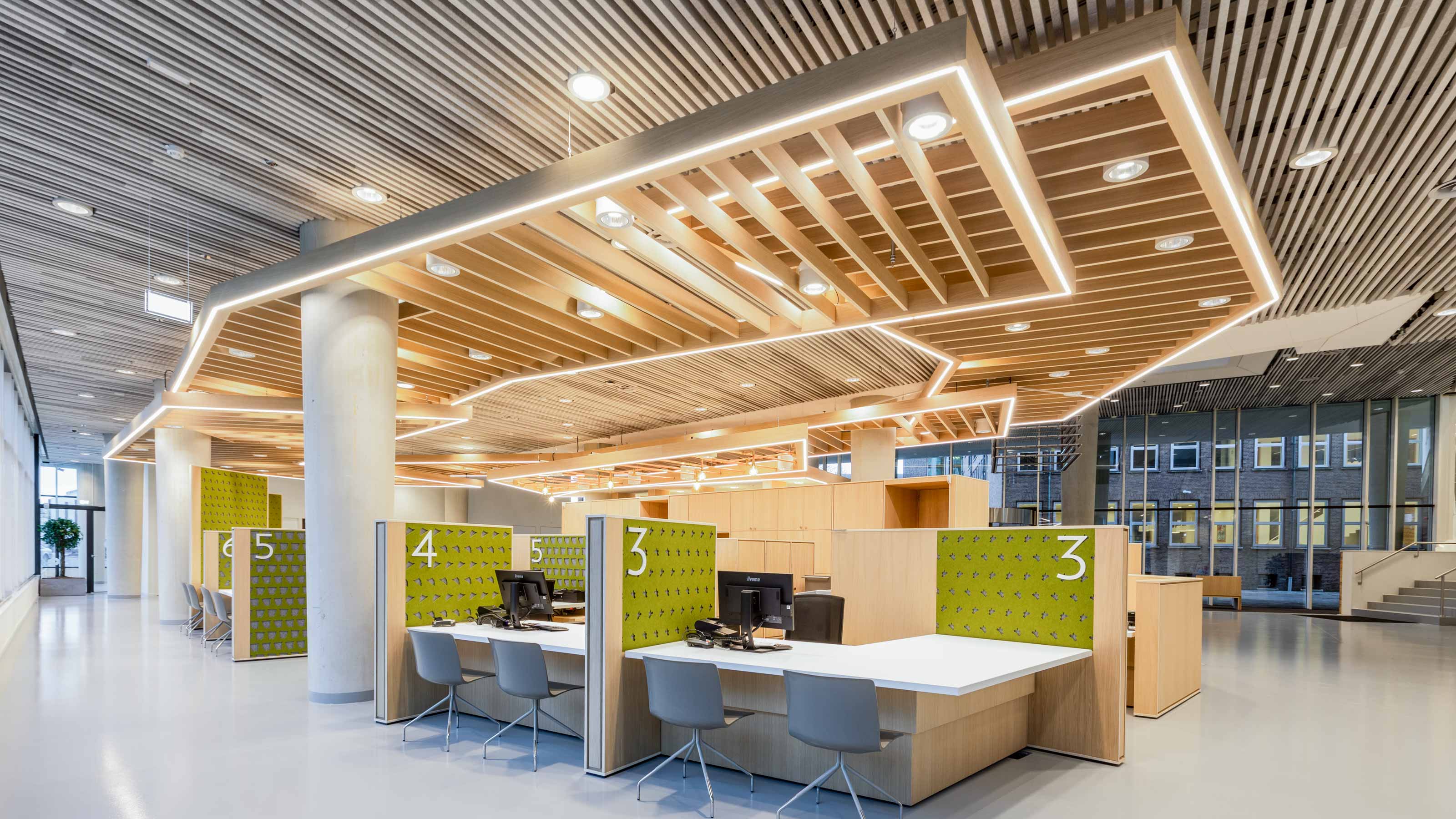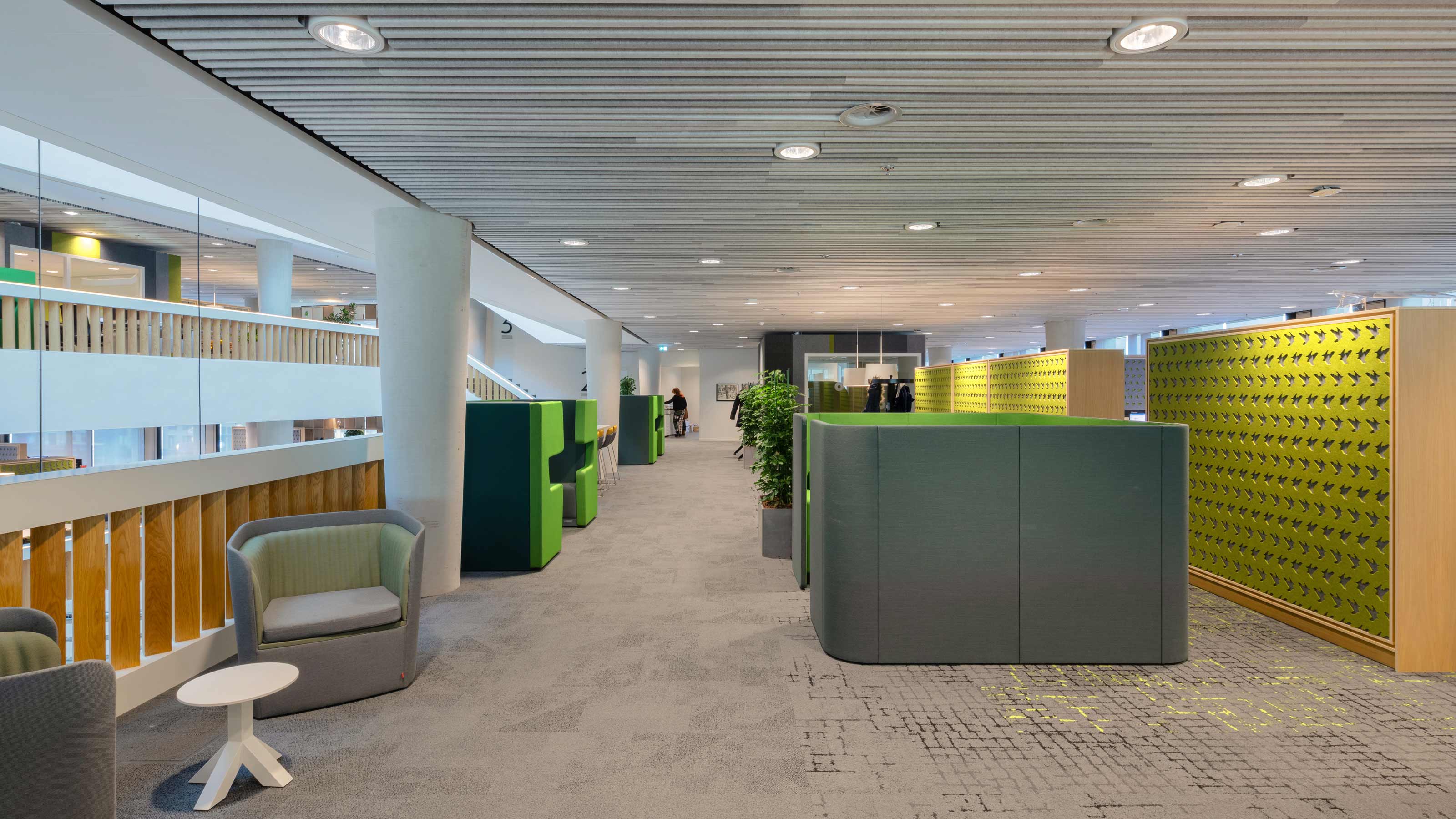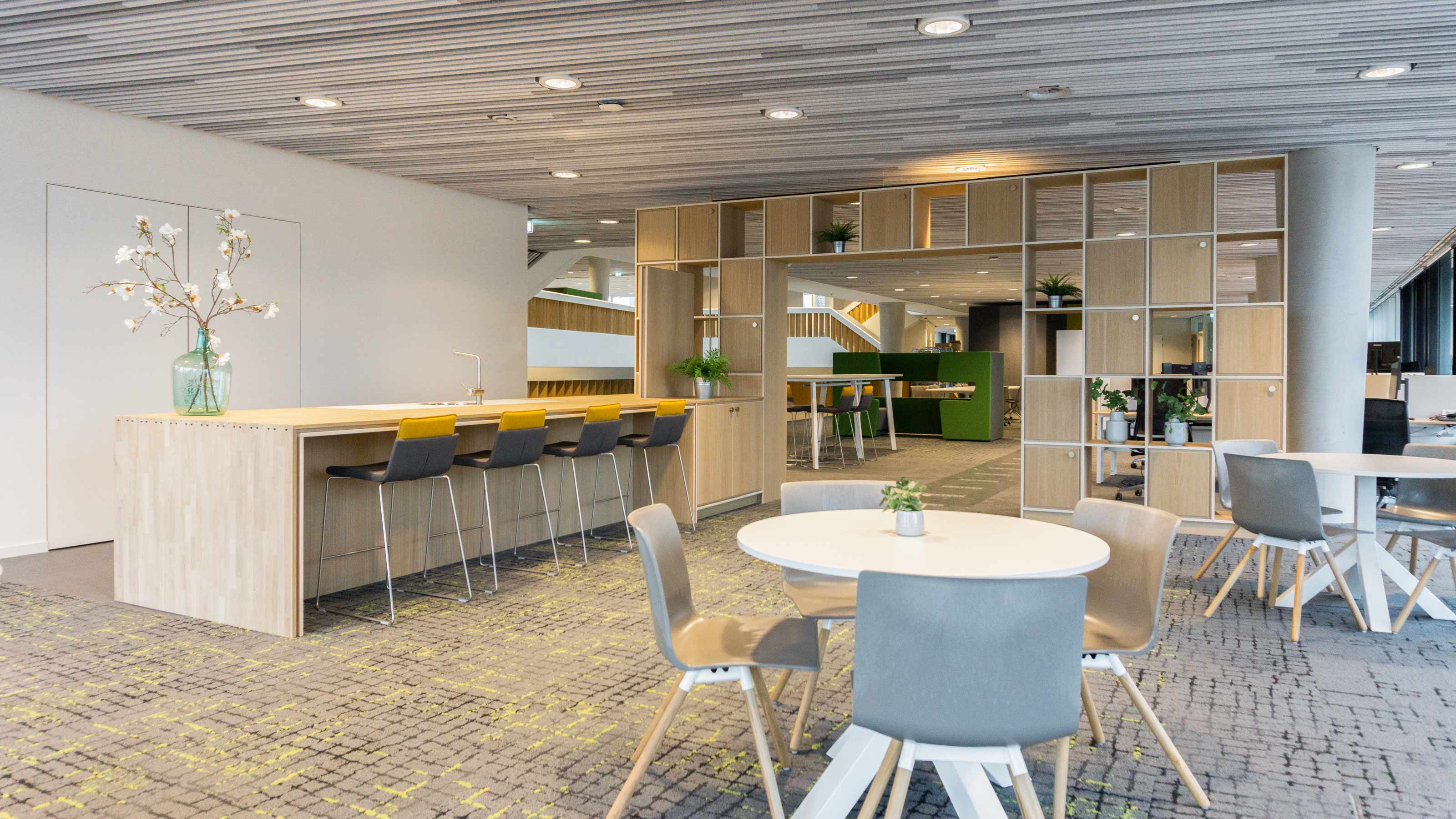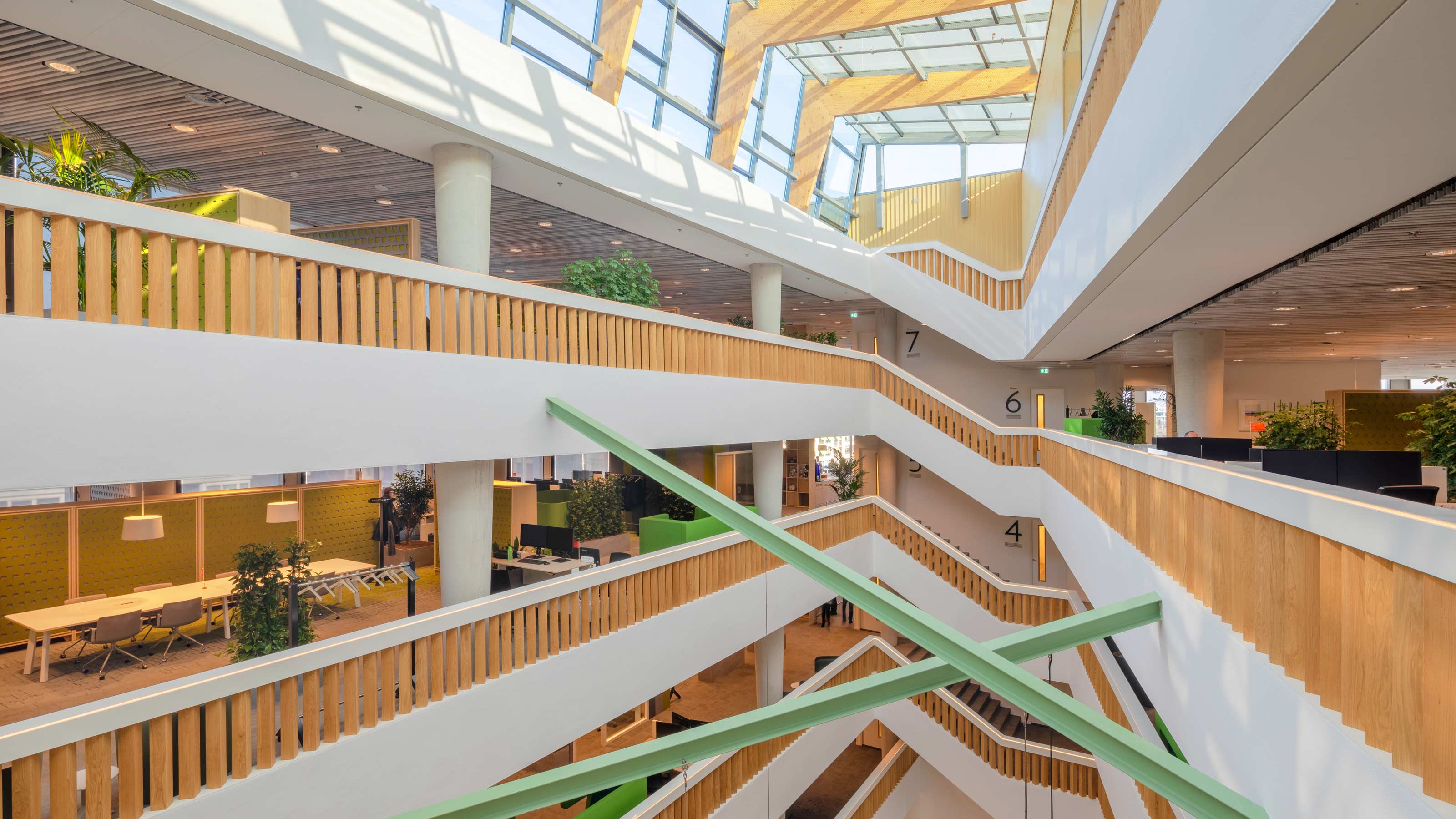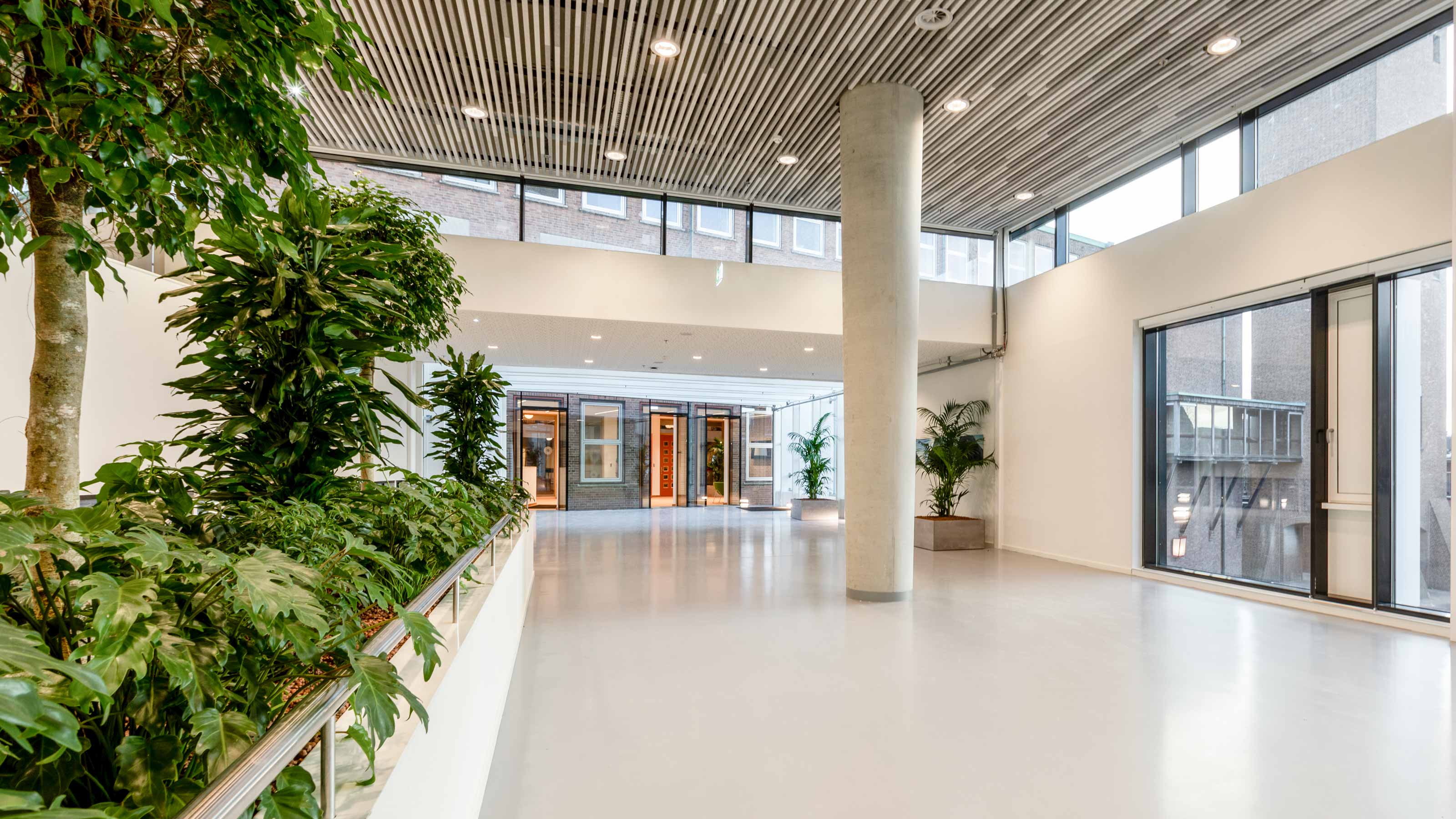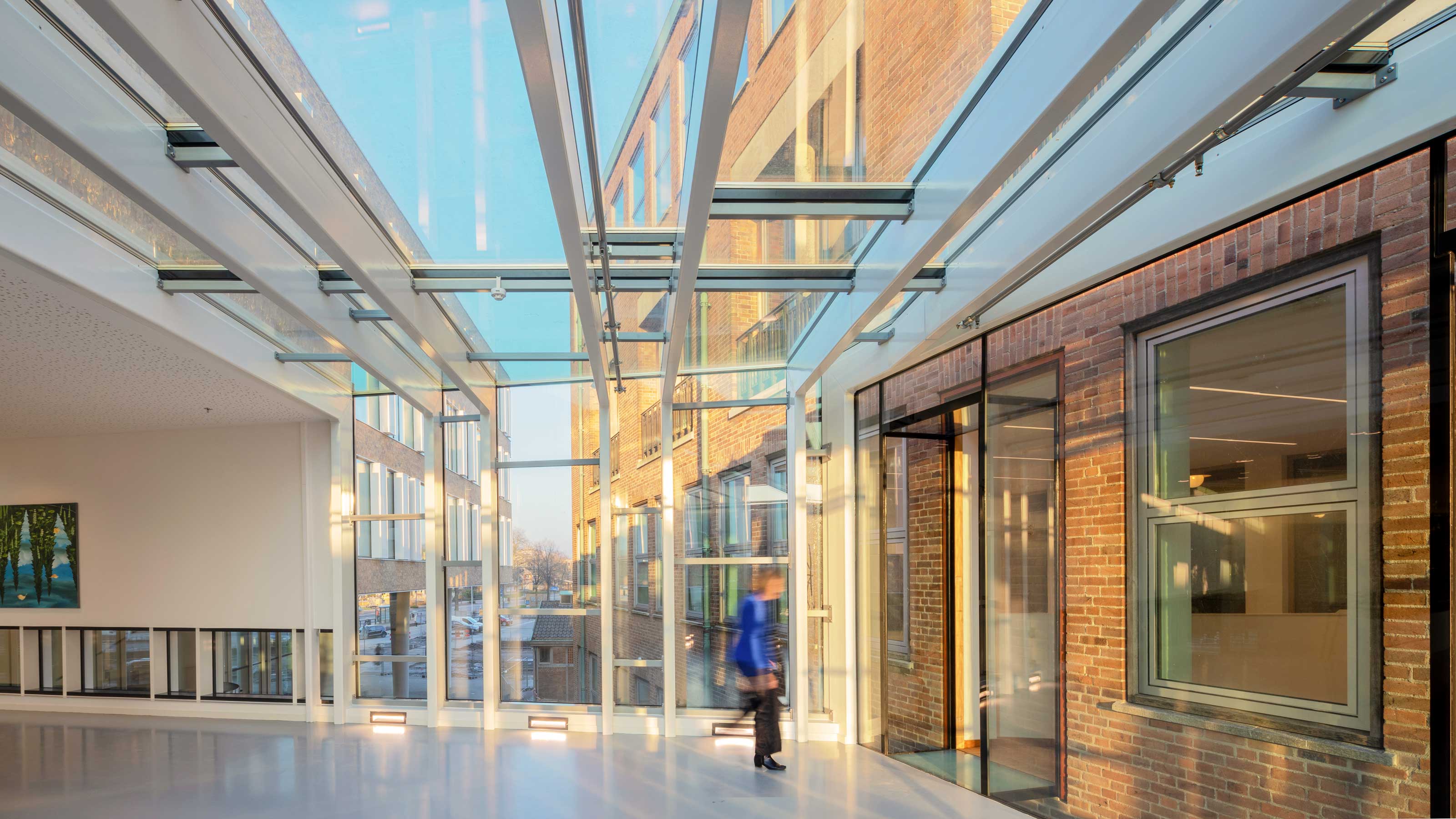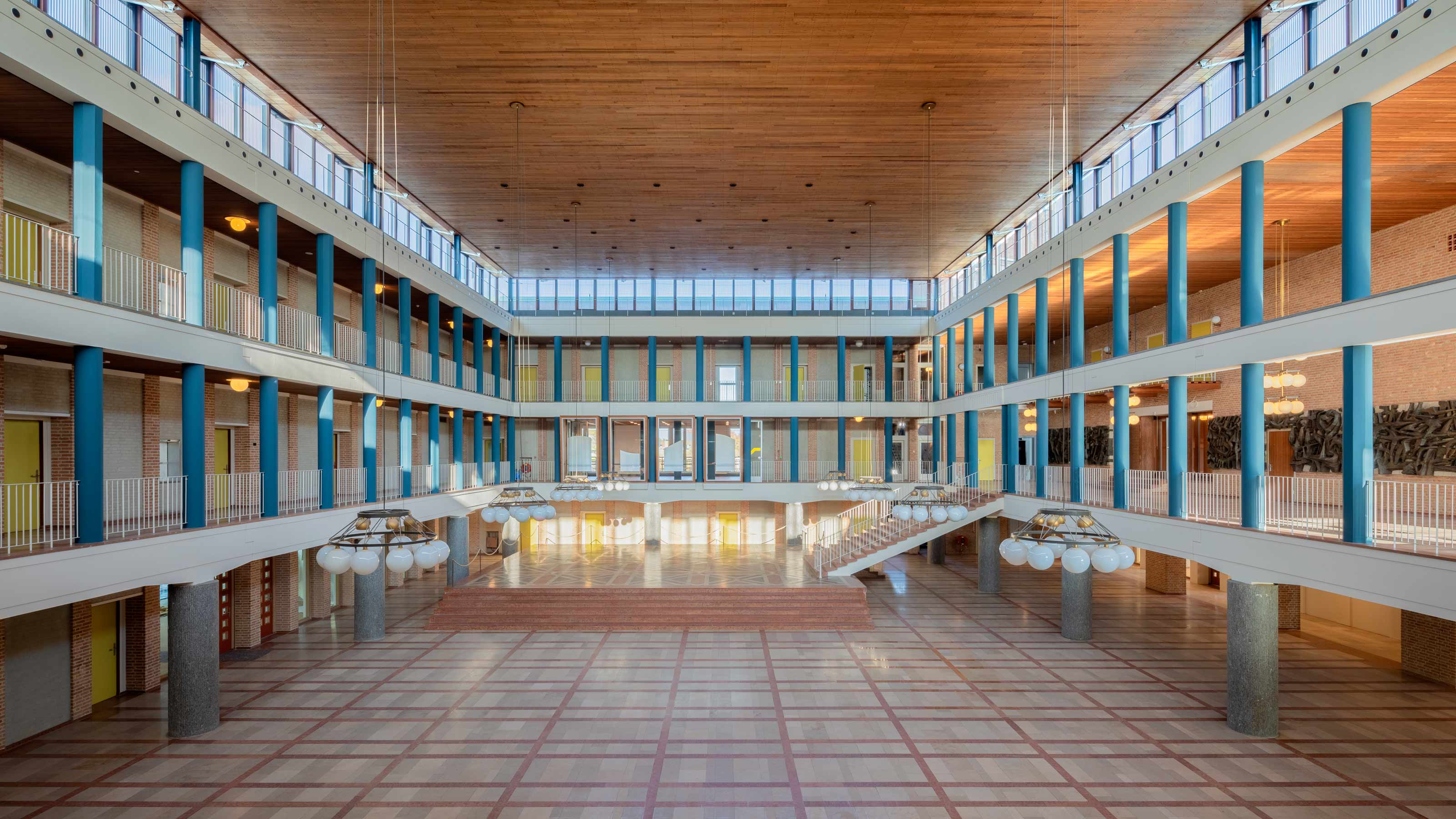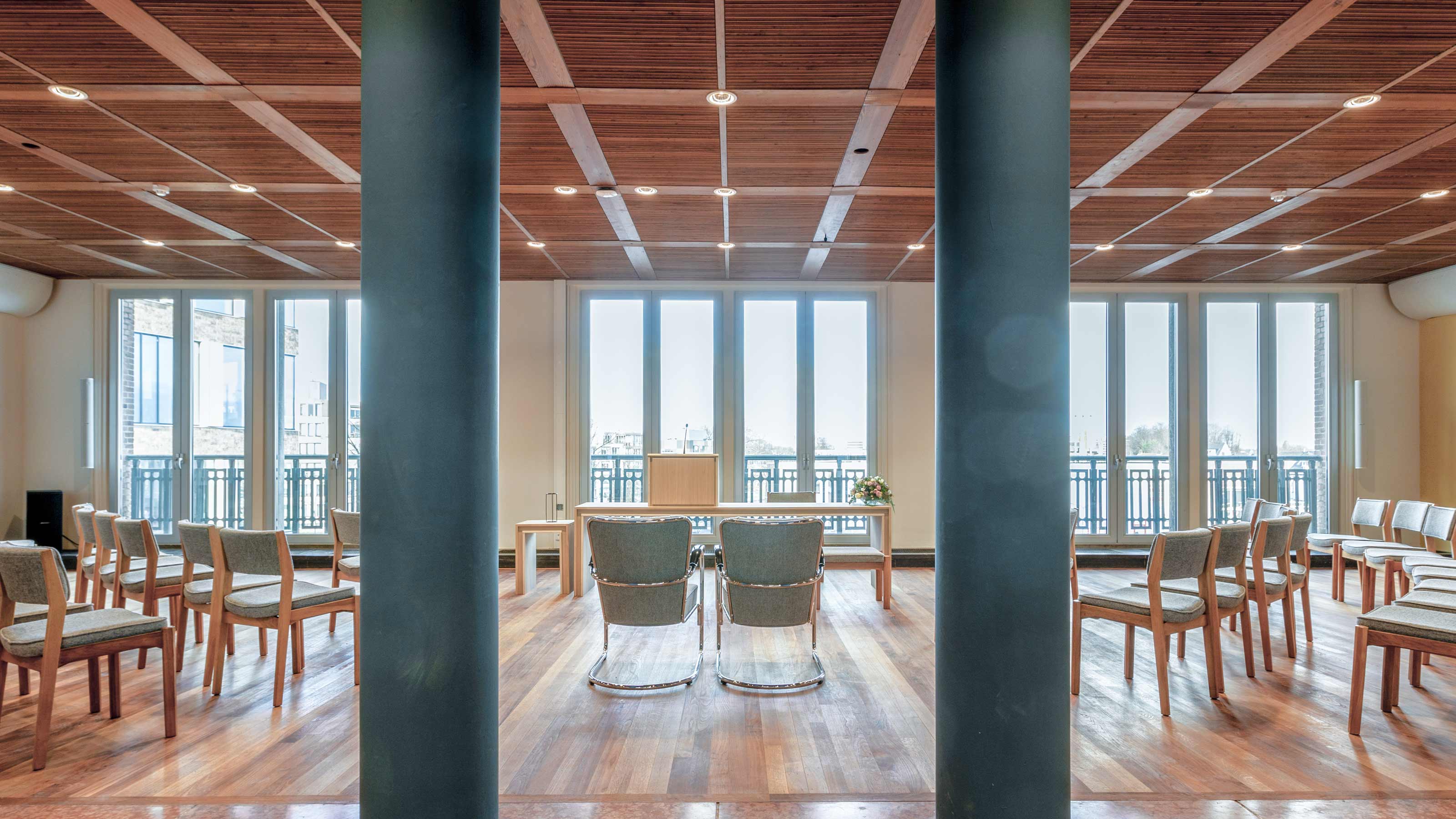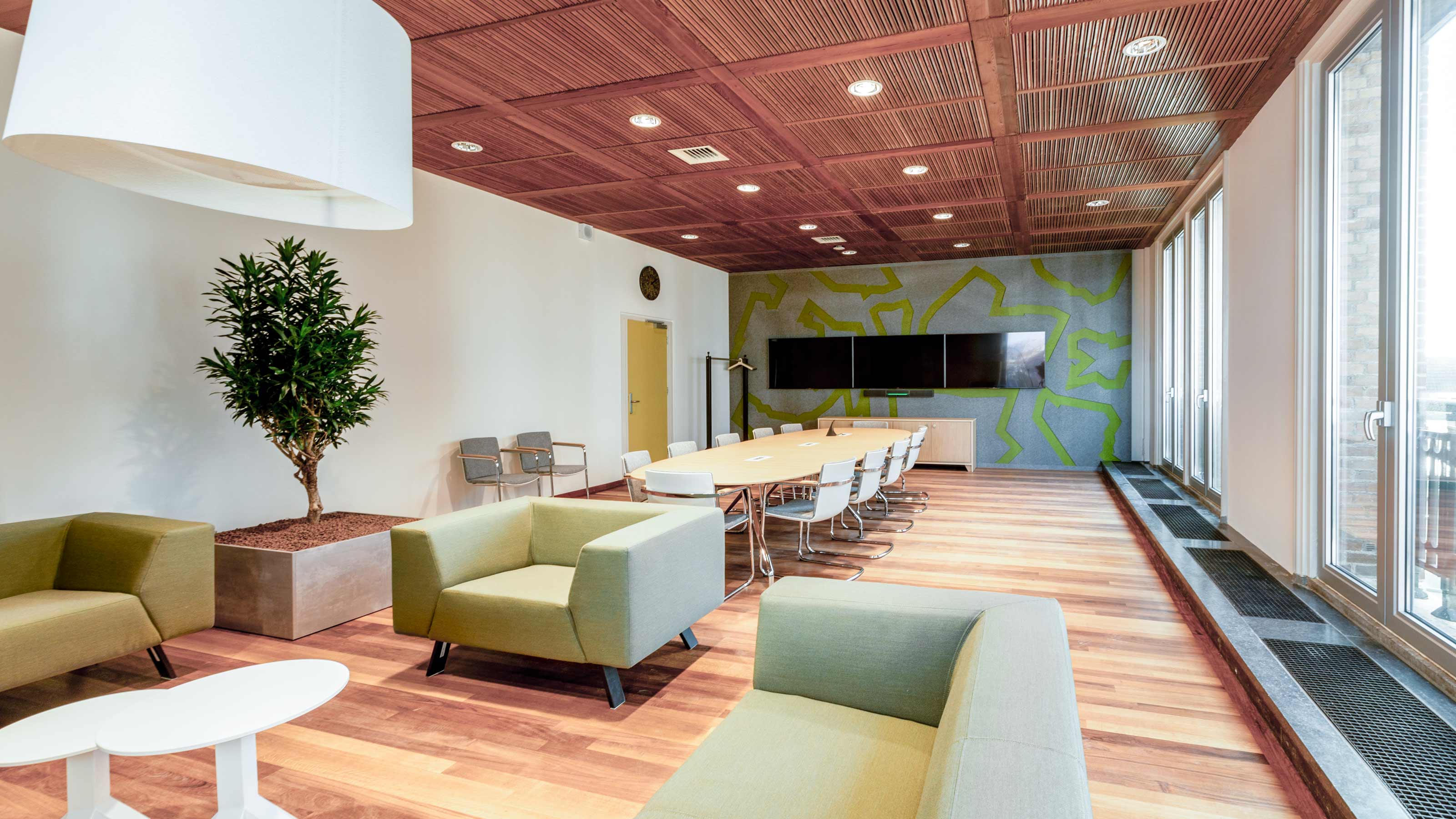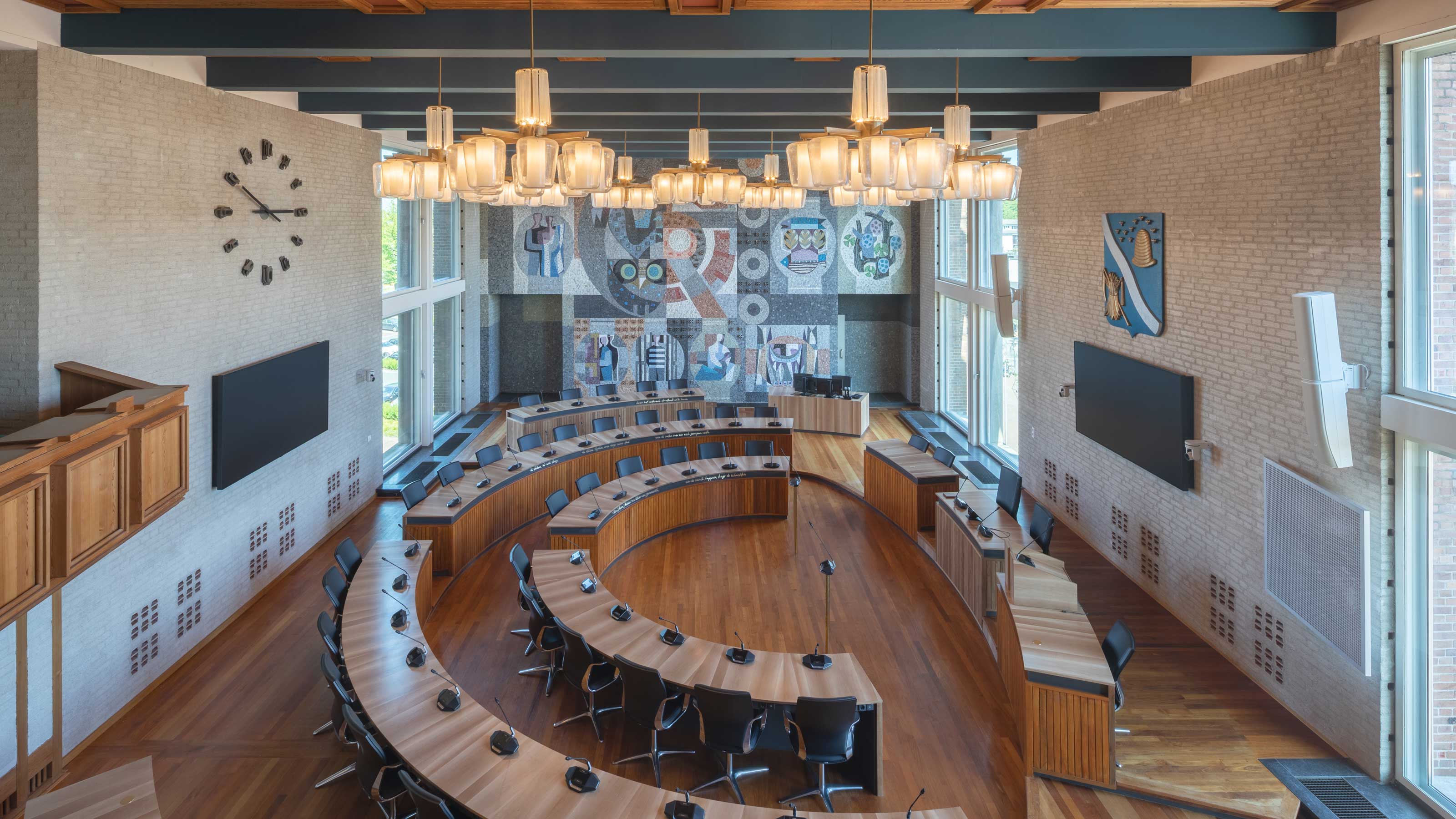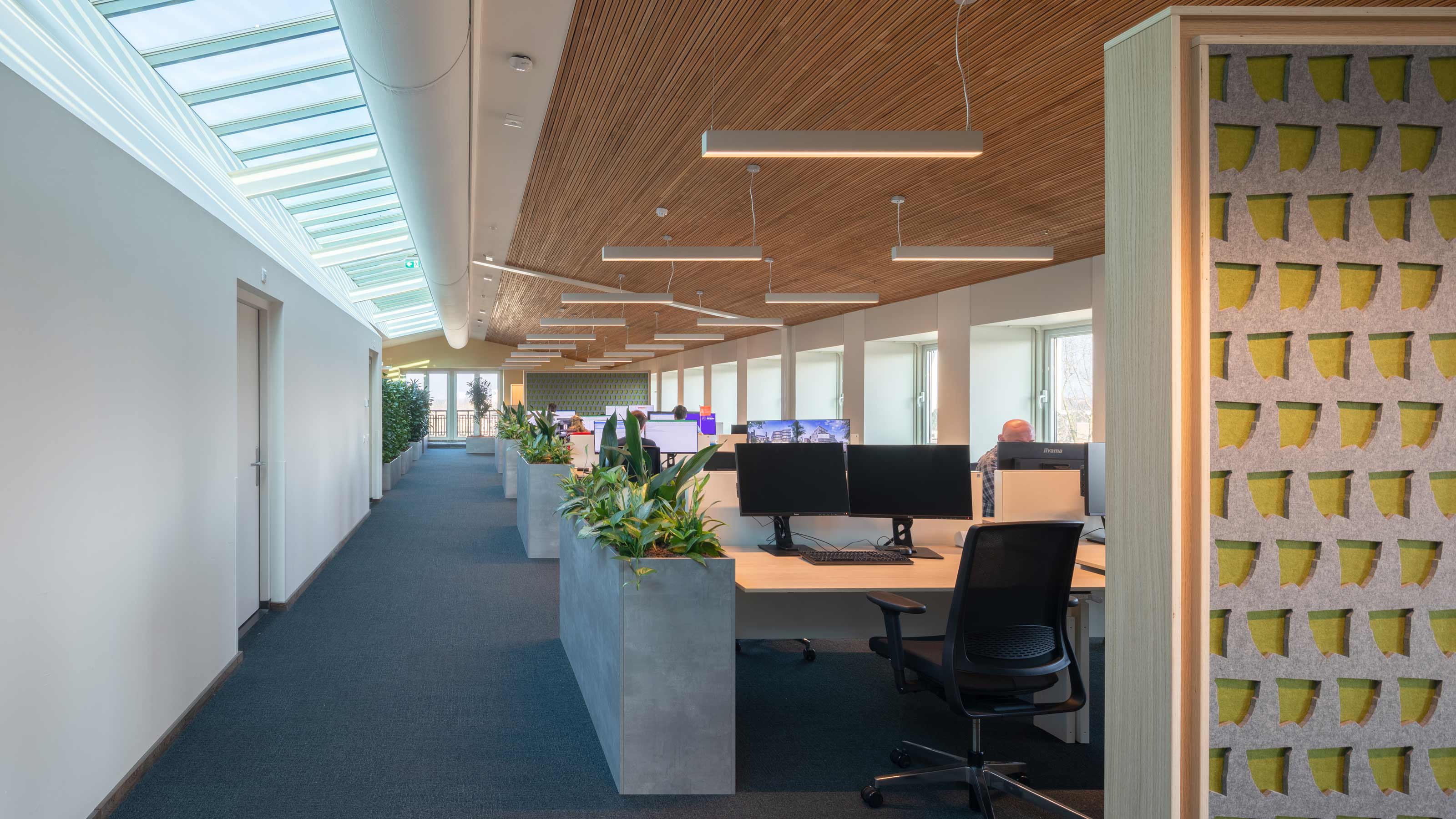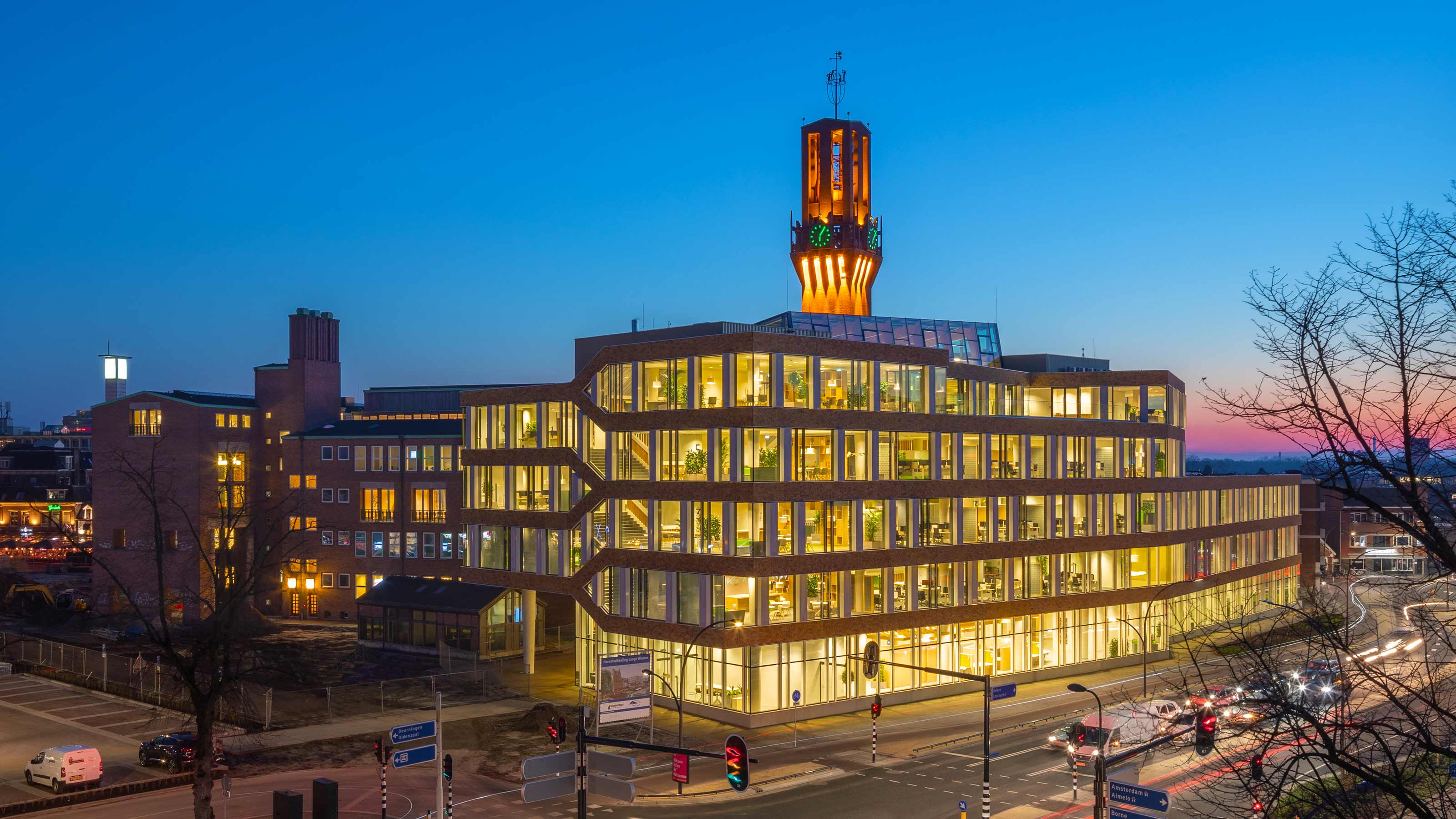Technique and tradition in perfect balance
The right combination of modern techniques and production methods with elements drawn from the locality. That is Hengelo City Hall. A contemporary, energy efficient and sustainable design that acknowledges the past while embracing the future.
The new Hengelo City Hall took shape in the vibrant heart of Hengelo. This contemporary and sustainable ensemble consists of the new municipal offices and the existing monumental city hall. Standing side by side and connected to each other, the two buildings form a single functional entity, but each has an ambience of its own. The historical monument is open in character, containing atmospheric workspaces and a central hall with striking and restored materials. Beside it is the new volume with its dynamic character, extraordinary spaciousness, copious daylight, sustainable innovations and local craft techniques.
Technique and tradition
The existing city hall is part of the collective memory of local people and vital element of city life owing to the many events that take place in the main hall. Important sources of inspiration for the design include the position and role of the city hall, as well as the characteristics of the city. The renovation and new design respect the iconic 1960s listed building by architect J.F. Berghoef. Hengelo techniques and traditions feature in both buildings. This approach brings both buildings together to form one ensemble with a typical Hengelo appearance, with a distinctive nod to the past and a high-tech look to the future.
Monumental city hall
The design for the new volume and renovation was approached in an integral manner right from the start. What makes the monumental city hall so remarkable is that it is one of the few remaining buildings from the city’s post-war reconstruction period built not in a modernist but in a traditional and European style. The restored and renovated city hall has been functionally reorganized, with the existing structure preserved where possible, and strengthened with a number of powerful interventions where necessary. The main hall has rediscovered its former function as a vibrant hub and is once again the place for (cultural) events and gatherings, as originally envisaged by Berghoef. Inserted into the monumental building is a central staircase, which connects the new municipal offices to the bike shed, the staff restaurant, the main hall and the bridge to the new municipal offices.
The spaces for the council groups, the double-height council café and the restaurant are located on the ground floor, creating visual contact with people passing outside. Grouped around the main hall on the first floor are meeting rooms and workspaces, all of which enjoy views of the city through large windows. The second floor houses the wedding hall, the council chamber and the citizens’ hall. The glass-roofed light street on the third and top floor has been restored, creating spacious and daylight-filled offices.
WHAT’S STRIKING ABOUT THIS COMPLEX IS THAT IT LOOKS LIKE TWO BUILDINGS FROM OUTSIDE, BUT ONCE YOU’RE INSIDE THAT DIFFERENCE DISAPPEARS TOTALLY AND THE BUILDINGS HAVE ONE IDENTITY, ONE APPEARANCE
Martin Fleer, Municipality of Hengelo
New municipal offices
On the entrance side the municipal offices align with the city hall, while on the other side the offices are bounded by a road, a shopping street and the square. The building envelope responds easily to the urban surroundings. Located on the ground floor, facing the square, is the main entrance. From here, visitors arrive into the spacious public hall. The first floor gives direct access to the ten-metre-wide passageway that links new and old. Staff have access to the seven floors arranged around the large hall. The split-level office areas feature flexible and quiet workspaces which are bathed in daylight from two sides. The office floors change colour from the bottom upwards from grey to green, a symbol of the journey from the city — filled with contrasts, tones from the steel industry and city bustle — to the great outdoors — with greenery, trees and silence. The higher you rise inside the building, the quieter and calmer the experience. Large expanses of glass feature prominently throughout, ensuring a continuous relationship with the city.
Despite their unique character the new municipal offices blend easily into the urban context. This is achieved with a mixture of contemporary production methods and local traditions from the steel industry, timber-framed farmhouses and salt towers, and natural materials from the region such as wood and brick.
Design through co-creation
The design for the ensemble was developed through an intensive and remarkable process of co-creation with staff working for the municipality. Staff put forward their wishes and could comment on the design during a series of workshops and presentations. This process made it clear that more cohesion in terms of the building and collaboration, and more direct communication and views of colleagues were important. As a result, located throughout the building are spacious and flexible workspaces, offering views of other staff and the surroundings. In this way, departments are visually connected to one another and directly accessible, which encourages collaboration.
Healthy building from top to bottom
Sustainability played an important role in all design and material decisions right from the start. Reusing the existing city hall contributed greatly to ambitions in this area. The reuse of materials, the use of new materials with low environmental impact and the addition of solar panels, sustainable installations and a smart connection to the new municipal offices all combine to significantly lower energy consumption. Heating and cooling integrated into the ceiling ensure a pleasant interior climate in the municipal offices. In addition, the concrete core activation (thermal activation) means that the floor is able to buffer heat and cold, creating a pleasant and energy-efficient interior climate. All measures combine to save the municipality more than half a million euro on its annual energy bill.
In line with the concept of a circular economy, the structure and shell of the new building have been designed with a possible future change of function in mind. The future-proof design is ready for transformation into a separate office block or an apartment complex.
Circular and sustainable solutions also feature right down to the smallest details in the interiors of both buildings. Items of fixed furniture — reception desks, pantries and display cabinets — have been designed with special Hengelo timber joints that allow them to be dismantled and reassembled elsewhere. This means they are directly reusable in a new location, and the materials can enjoy a second life. Some 400 m² of melamine panels from the original interior have been reused in new cabinets and flexible partitions. Both are faced in PET felt: acoustic sheets made of recycled PET bottles. The contours of Hengelo neighbourhoods are stencilled into the PET felt, while the same contours are incorporated into the wallpaper. New materials are cradle-to-cradle and have a low environmental impact. They include the FSC-certified inland oak and fast-growing Dutch poplar. The restaurant is also as sustainable as possible. Local caterers supply the produce and all the fruit and vegetable waste is ground down, collected at one central point and processed into dry compost that is sent to a children’s farm for use in the vegetable garden.
Boost for Hengelo
The newly redeveloped city hall and municipal offices have triggered a social and economic intensification of this wonderful site in the city centre. The area is transforming from an unattractive neighbourhood blighted by vacant properties and underused sites into a high-quality, vibrant and pleasant place with new street surfacing, new greenery and new entrepreneurs. The location is very accessible by bike and public transport, and the car park contains electric shared cars for use by staff. Some 700 employees who previously worked far outside the centre now arrive here to work every day. In addition, 100,000 visitors come to the municipal offices each year. Local Hengelo entrepreneurs who provide services in the city hall generate a vibrant bustle and economic activity inside a true Hengelo City Hall that is welcoming for local people and strengthens life in the city centre.
EGM architects was responsible for the overall redevelopment of the city hall, and designed the new volume and the interiors of both the old and new volumes. HVE Architects, in collaboration with Berns architecture, restored the monumental city hall. The construction was carried out by the Van Wijnen & Trebbe building consortium, and the city hall by Koopmans Bouwgroep in Enschede.
Awards & Recognitions
Municipality of Hengelo - Silver Medal of Honour Victor de Leeuw / EGM architects
Photography: Bart van Hoek, JLF fotostudio, HarmelingInterieurs
